#sitting bull
Text


Michael Greyeyes as Chief Sitting Bull,
Jessica Chastain as Caroline Weldon
WOMAN WALKS AHEAD (2017) dir. Susanna White
#woman walks ahead#michael greyeyes#jessica chastain#perioddramaedit#perioddramasource#perioddramagif#perioddramacentral#periodgif#filmedit#filmgifs#dailyflicks#cinemapix#cinematv#jchastainedit#sitting bull#caroline weldon#chastaindaily#native american#just finished watching this film yesterday and i loved it!#I think Michael Greyeyes is becoming one of my favourite actors#and it doesn't help that he's so kingly and beautiful#a24#a24 films#a24edit
109 notes
·
View notes
Text
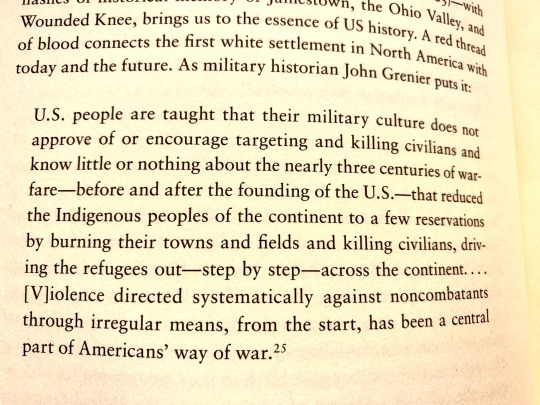
“U.S. people are taught that their military culture does not approve of or encourage targeting and killing civilians and know little or nothing about the nearly three centuries of war-fare-before and after the founding of the U.S.-that reduced the Indigenous peoples of the continent to a few reservations by burning their towns and fields and killing civilians, driving the refugees out--step by step--across the continent....Violence directed systematically against noncombatants through irregular means, from the start, has been a central part of Americans' way of war. “
Military Historian John Grenier
#us history#wounded knee#sand creek#trail of tears#the long walk#bear river#thanks taking#in Country#🇺🇸#land back#crazy horse#tecumseh#sitting bull#Geronimo#chief joseph#emiliano zapata#Joaquin murrieta#Pó Pay#captain Jack#war crimes
148 notes
·
View notes
Text
On Dec 15th, we venerate Elevated Ancestor & Saint Tataηka Íyotake aka Chief Sitting Bull on the 133rd anniversary of his passing 🕊 [for our Hoodoos of First Nations descent]
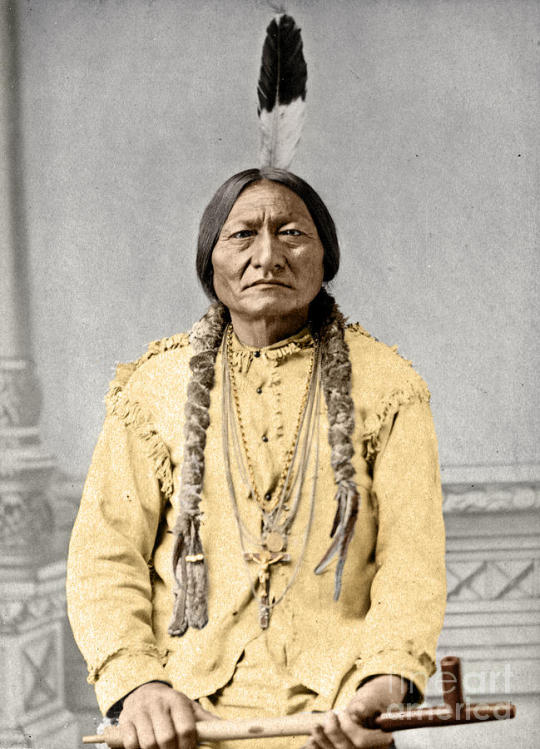
Sitting Bull, of the Hunkpapa Lakota, was a fierce political leader & holy man known to be a great father, husband, & friend to all. Under him, all the Lakota bands united for survival in the Northern Plains, as he spearheaded their resistance against European invasion. He was known for his legendary courage, unyielding defiance toward U.S. military power, & contemptuous of the many broken U.S. political promises.
Tatáŋka Íyotake was born to a prominent family of chiefs on the Grand River in present-day South Dakota at a place called, "Many Caches" - known for its abundant food storage pits. He was given his name, which described a buffalo bull sitting intractably on his haunches. This, he would grow live up to.
As a young man, Tatáŋka Íyotake joined two prominent groups within his community. He became a distinguished member of the Silent Eaters (a group concerned with tribal welfare) & leader of the Strong Heart Warrior Society. At 14, he joined his father & uncles on a raid against the Crow. Here, he first encountered White soldiers as the U.S. Army had mounted a broad campaign in retaliation for the Santee Rebellion in Minnesota, enchanting the Lakota had no affiliation with. That following year, in 1816, Tatáŋka Íyotake fought U.S. troops again at the Battle of Killdeer Mountain. Later, in 1865, he led a siege against the newly established Fort Rice in North Dakota. Widely respected for his bravery & insight, in 1868, Tatáŋka Íyotake became Head Chief of Lakota Nation.
By 1874, the stage for war between Sitting Bull & the US Army was set once an expedition led by General George Armstrong Custer confirmed gold had been discovered in the Dakota Territory’s the Black Hills, an area sacred to the Lakota bands. This land was decreed off-limits to white settlement by the Fort Laramie Treaty of 1868. Despite this ban, prospectors began a rush to the Black Hills. Once U.S. government efforts to purchase the Black Hills failed, the Fort Laramie Treaty was dismissed. The commissioner of Indian Affairs decreed that all Lakota not settled on reservations by January 31, 1876, would be considered hostile.
Rightfully so, Sitting Bull and his people held their ground. In March, 3 lines of federal troops invaded the area. Sitting Bull summoned the Lakota and their allies, the Cheyenne, & Arapaho to his camp on Rosebud Creek in Montana Territory. There, he led them in the sundance ritual, offering prayers to Wakáŋ Táŋka (Great Spirit). Sitting Bull slashed his arms 100 times in sacrifice for his people. During this ceremony, he shared that he'd had a vision. He saw soldiers falling into the Lakota camp like grasshoppers falling from the sky.
Inspired by this vision, the Oglala Lakota leader, War Chief Crazy Horse, set out for battle with a band of 500 warriors at the Battle of the Rosebud. To celebrate this victory, the Lakota moved their camp to the valley of the Little Bighorn River. They were joined by 3,000 more Native warriors who had abandoned the reservations to follow Sitting Bull.
On June 25th, the U.S. 7th Cavalry launched their attack under George Armstrong Custer. They rushed the Indian encampment as if in fulfillment of Sitting Bull’s vision. Yet they were severely outnumbered & thus defeated.
White outrage at this military catastrophe spurred thousands more cavalrymen to the area. Over the next year, they relentlessly pursued the Lakota bands.
Though many were forced into surrender, Sitting Bull remained defiant. In May 1877, he led his band to Canada, beyond the reach of the U.S. Army. When a U.S. General traveled north to audaciously offer him a pardon in exchange for settling on a reservation, Sitting Bull angrily dismissed him.
Four years later, in the wake of European invaders driving the Buffalo to near instinction, Sitting Bull found it nearly impossible to feed his people. So, he moved south to face surrender. On July 19, 1881, Sitting Bull’s young son handed his father’s rifle to the U.S. commanding officer of Fort Buford in Montana. Through this action, Sitting Bull hoped to teach his son “that he had become a friend of the Americans.” He also said, “I wish it to be remembered that I was the last man of my tribe to surrender my rifle.” He asked for the right to cross back & forth into Canada whenever he wished & for a reservation of his own on the Little Missouri River near the Black Hills. Instead, he was sent to Standing Rock Reservation. His warm reception there raised Army fears about a fresh uprising. So, Sitting Bull and his people were taken further down the Missouri River to Fort Randall. They were held as prisoners of war for nearly 2 more years.
Finally, on May 10, 1883, Sitting Bull rejoined his tribe at Standing Rock. The Indian Agent in charge of the reservation was determined to deny him any special privileges. And so, Sitting Bull was forced to work in the plantation fields. Yet when a delegation of U.S. Senators came to discuss opening part of the reservation to Whitea, he spoke forcefully, though futilely, against it.
In 1885, Sitting Bull was allowed to leave the reservation to join Buffalo Bill’s Wild West Show. He earned $50 a week for riding once around the arena. Sitting Bull also named his price for his autograph & picture. Unable to tolerate White society any longer, he stayed with the show for 4 months.
Returning to Standing Rock, Sitting Bull lived in a cabin near his birthplace on the Grand River; still rejecting the seeds of the colonialism - Christianity & giving up the traditional ways of life - as the reservation’s rules required. He did, however, send his children to a Christian school because he believed the next generation of Lakota would need the education of their oppressors to survive in the new world.
Here, he had another vision. He saw a meadowlark on a hillock beside him say,“Your own people, Lakotas, will kill you.” Nearly 5 years later, this vision would come to fruition.
In the fall of 1890, a Minŋecoŋjou Lakota named Kicking Bear came to Sitting Bull with news of the Ghost Dance, a ceremony that promised to rid the land of colonizers & restore the Indian way of life. Lakota had already adopted the ceremony at the Pine Ridge & Rosebud Reservations, and Indian Agents there had already called for troops to bring the growing movement under control.
At Standing Rock, the authorities feared Sitting Bull, still revered as a powerful spiritual leader, would join the Ghost Dancers as well. They sent 43 Lakota police officers to seize him. Before dawn on December 15th1890, the officers burst into Sitting Bull’s cabin & dragged him outside, where his followers were gathering to protect him. In the gunfight that followed, one of the Lakota police officers shot Sitting Bull in the head.
Today, Sitting Bull rests close to his birthplace near Mobridge, South Dakota. A granite shaft marks his grave.
"They claim this mother of ours, the Earth, for their own use, and fence their neighbors away from her, and deface her with their buildings and their refuse." - Sitting Bull.
We pour libations & give him💐 today as we celebrate him for his inspirational leadership, fearless figuring spirit, power in prayer, & his deep faith in Great Spirit.
Offering suggestions: a smoking pipe with tobacco, Lakota music, bison meat served with wild potatoes & prairie turnips
‼️Note: offering suggestions are just that & strictly for veneration purposes only. Never attempt to conjure up any spirit or entity without proper divination/Mediumship counsel.‼️
#hoodoo#hoodoos#atr#the hoodoo calendar#ancestor veneration#elevated ancestors#Sitting bull#Lakota Nation#Plains Indians#First Nations#Hunkpapa Lakota
39 notes
·
View notes
Photo

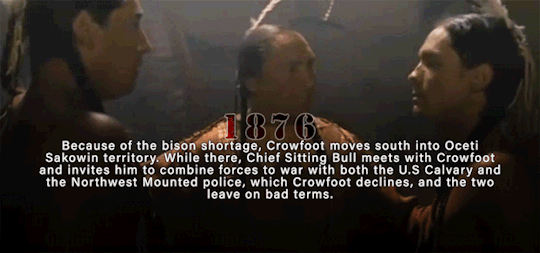

[image description: gifset stacked horizontally. The first gif features five Plains Native horsemen galloping down a hill and bearing weapons, with a text overlay which reads, “1873, Chief Crowfoot’s son is killed during a raid on a Cree camp, causing Crowfoot to swear to avenge him. During a raid on a Cree camp sometime later, Crowfoot captures a young Cree man with a striking resemblance to his son. Crowfoot adopts the young man and gives him the name of his dead son, ‘Wolf thin legs’. The young man he adopted was Poundmaker, who became Chief once returned to his band. This adoption led to better relations between the Blackfoot and Cree”.
The second gif shows three Native men in a tipi, speaking to each other with intense gazes. They each have a feather in their hair. The text on top reads, “1876, Because of the bison shortage, Crowfoot moves south into Oceti Sakowin territory. While there, Chief Sitting Bull meets with Crowfoot and invites him to combine forces to war with both the U.S Calvary and the Northwest Mounted police, which Crowfoot declines, and the two leave on bad terms.“
The last gif depicts two scenes edited together. On the left is an adolescent boy with brown skin and dark hair with twin braids. On the right is an older Native man sitting on the grass, with his hair in braids and wrapped in fur, looking pensively. The text reads, “Exiled into Canada after the Battle of Little Big Horn, Crowfoot realizes Sitting Bull and his people arrived as refugees. Wanting to make amends, Sitting Bull offered tobacco to Crowfoot, who gladly accepted. Sitting Bull was so impressed with him that he named his son after him”. end description.]
Crowfoot’s interesting allyships with other Chiefs from previously enemy tribes of the Blackfoot.
#historyedit#native american history#ndn#native american#first nations history#canadian history#history#american history#crowfoot#sitting bull#poundmaker#Crowfoot just being a standup guy compilation. This has been a Crowfoot appreciation post#this history is just really interesting and not really talked about#I feel like not many people know these three all knew each other#justin's edits
226 notes
·
View notes
Text

Still standing. 🪶🟧🟫💨
#first nations#american indian#native american#native people#native americans#First Nation#basquiat#peace pipe#standing rock#sioux city#sioux#crazy horse#sitting bull#Navajo#Apache#iroquois#lakota#south dakota#folk art#pow wow#teepee#water protectors#wounded knee#trail of tears#comanche#seminole#Foxwoods#red skins#mount rushmore#jean michel basquiat
15 notes
·
View notes
Text
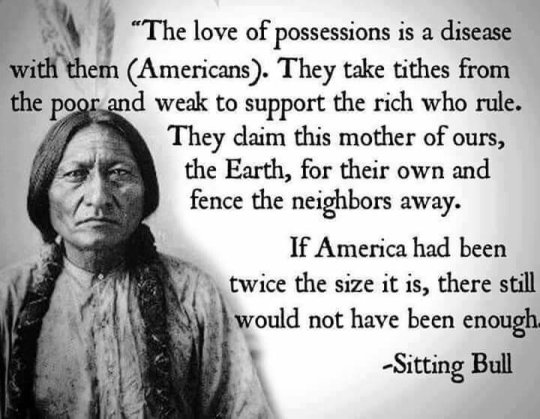
#indigenous peoples day#quotes#sitting bull#american history#love of possessions#love of power#think for yourself#question everything
161 notes
·
View notes
Text
Legendary Indian chief "Sitting Bull":
▪His story started when the whites invaded his land. Because the whites had slaughtered all the natives like animals.
▪Sitting Bull was the leader of the Lakota tribe of the Sioux people living in present-day South Dakota. He was born in 1831. He got this name at the age of 14 because of the courage and skill he showed in battle. The Indian chief achieved his greatest fame in the Battle of Little Bighorn between Native American troops and the US army. He migrated his tribe to Canada for fear of genocide.
▪On December 15, 1890, Sitting Bull was killed by the Native American police force who, ironically, sided with the US administration.
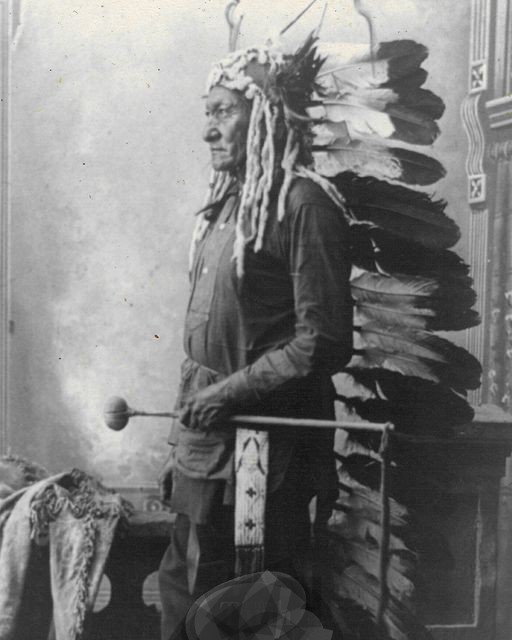
الزعيم الهندي الأسطوري "الثور الجالس":
بدأت قصته عندما اجتاح البيض أرضه. لأن البيض قد ذبحوا جميع السكان الأصليين مثل الحيوانات.
كان سيتينج بول زعيم قبيلة لاكوتا لشعب سيوكس الذين يعيشون في ولاية ساوث داكوتا الحالية. ولد عام 1831. حصل على هذا الاسم في سن 14 بسبب الشجاعة والمهارة التي أظهرها في المعركة. حقق الزعيم الهندي أعظم شهرته في معركة ليتل بيجورن بين القوات الأمريكية الأصلية والجيش الأمريكي. هاجر قبيلته إلى كندا خوفا من الإبادة الجماعية.
▪ في 15 ديسمبر 1890 ، قُتلت Sitting Bull على يد قوة شرطة الأمريكيين الأصليين الذين ، من سخرية القدر ، انحازوا إلى الإدارة الأمريكية.
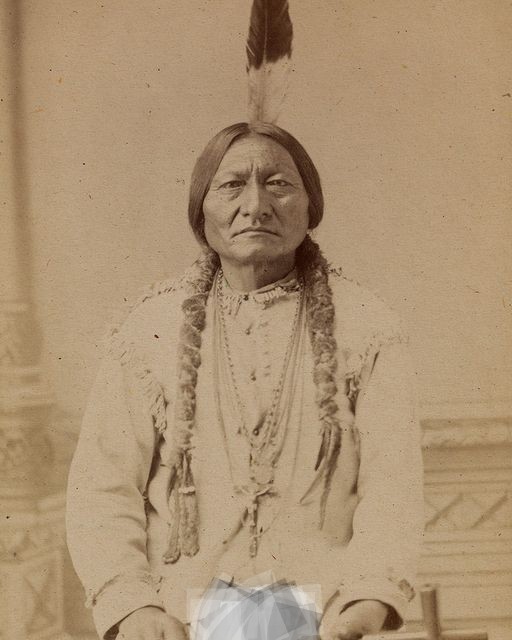


Efsanevî Kızılderili şefi "Oturan Boğa ":
▪Hikâyesi beyazların onun topraklarını işgal etmesiyle başladı. Çünkü beyazlar hayvan boğazlar gibi katletmişlerdi bütün yerlileri....
▪Oturan Boğa, bugünkü Güney Dakota'da yaşayan Siyu halkının Lakota kabilesinin lideriydi. 1831’de dünyaya geldi. Savaşta gösterdiği cesaret ve beceri nedeniyle 14 yaşında bu adı aldı. Kızılderili şefi en büyük şöhretini, Kızılderili birlikleriyle ABD ordusu arasındaki Little Bighorn Muharebesi’nde elde etti. Soykırım korkusuyla kabilesini Kanada’ya göç ettirdi.

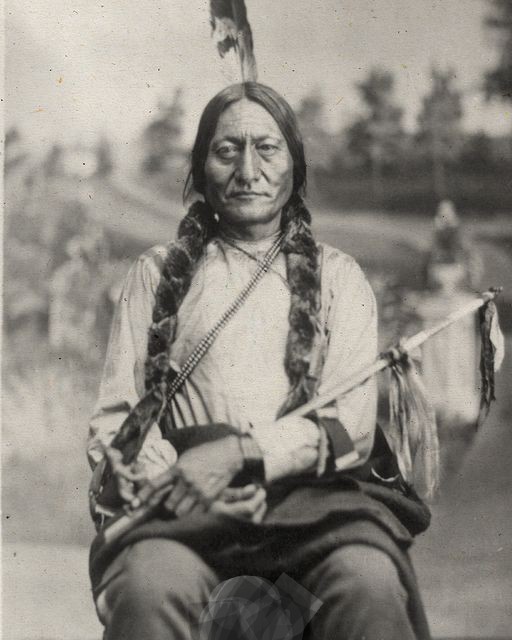

▪15 Aralık 1890'da Oturan Boğa, ironik bir şekilde ABD yönetimi tarafına geçen yerlilerden oluşan polis birliği tarafından öldürüldü.
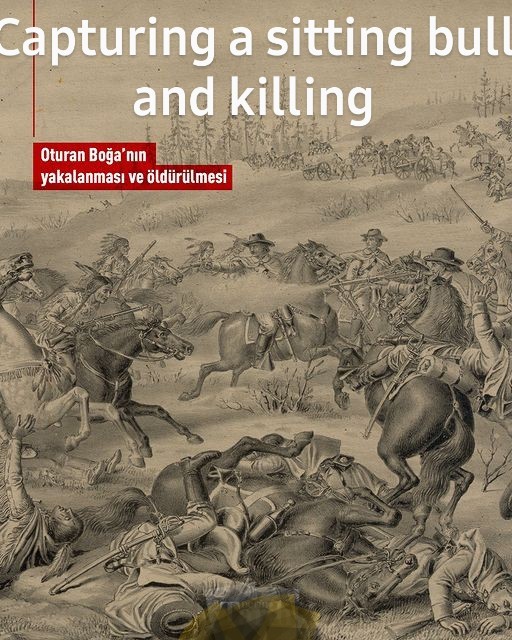

https://www.instagram.com/nevzat.boyraz44/?hl=tr
#sitting bull#usa#america#Indian#genocide#wild west#wild white man#white man#travel photography#travel#travel destinations#view#what the photos tell#fotografando#discourse#explorer#keşfetteyiz#keşfet#photos#viral photo#beautiful post#postviral#jalan dahlia raya blok a19 no. 09#türkiye#doğa#manzara#natural#europe#africa#fotoğrafia
64 notes
·
View notes
Text
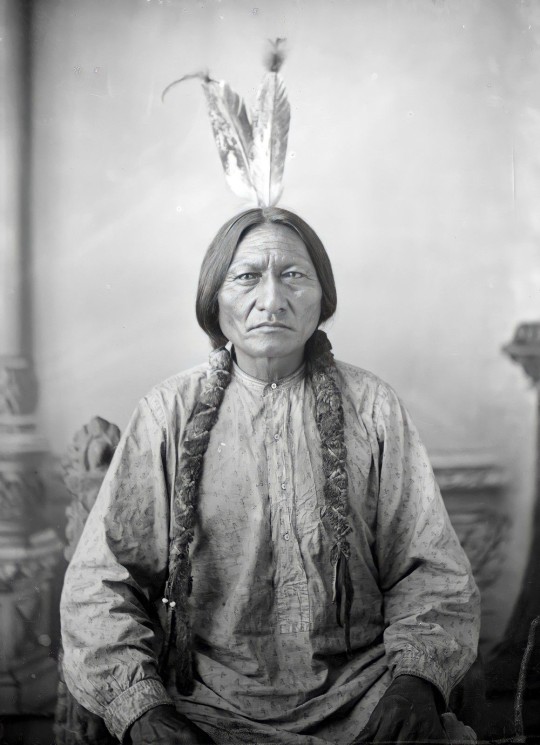
Sitting Bull in 1883
Tȟatȟáŋka Íyotake, more commonly known Sitting Bull, was a Hunkpapa Lakota leader who led his people during years of resistance against United States government policies. He was killed by Indian agency police on the Standing Rock Indian Reservation during an attempt to arrest him, at a time when authorities feared that he would join the Ghost Dance movement.
30 notes
·
View notes
Text
HARLAN CROW / CLARENCE THOMAS #YOURFAVEISANTINATIVE
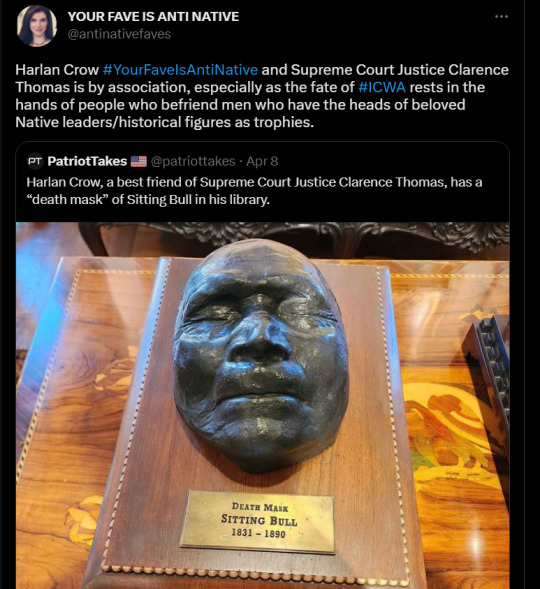
#Harlan Crow#Clarence Thomas#anti native racism#anti-native racism#Sitting Bull#Your Fave is Anti Native#YourFaveIsAntiNative
20 notes
·
View notes
Photo

For 64 years you have kept me and my people and treated us bad. What have we done that you should want us to stop? We have done nothing. It is all the people on your side that have started us to do all these depredations. We could not go anywhere else, and so we took refuge in this country. It was on this side of the country we learned to shoot, and that is the reason why I came back to it again. I would like to know why you came here. In the first place, I did not give you the country, but you followed me from one place to another, so I had to leave and come over to this country. I was born and raised in this country with the Red River Half-Breeds, and I intend to stop with them. I was raised hand in hand with the Red River Half Breeds, and we are going over to that part of the country, and that; is the reason why I have come over here. That is the way I was raised, in the hands of these people here, and that is the way I intend to be with them. Y
ou have got ears, and you have got eyes to see with them, and you see how I live with these people. You see me? Here I am! If you think I am a fool you are a bigger fool than I am. This house is a medicine-house. You come here to tell us lies, but we don't want to hear them. I don't wish any such language used to me; that is, to tell me such lies in my great Mother's house. Don't you say two more words. Go back home where you came from. This country is mine, and I intend to stay here, and to raise this country full of grown people. See these people here. We were raised with them.
—Tȟatȟáŋka Íyotake (Sitting Bull), speaking to the U.S. Secretary of War & Secretary of the Interior, as recorded by the Northwest Mounted Police, Fort Walsh, Saskatchewan, Canada, Oct 18, 1877
[h/t Scott Horton]
53 notes
·
View notes
Text










This is Rico. Buffalo Bill gave him to me. He's a circus horse. It'd be just like sitting on a chair. When you click your tongue … he paws the ground. When he hears a gunshot … he dances.
WOMAN WALKS AHEAD (2017)
@undomesticaated 🖤🖤
5 notes
·
View notes
Text
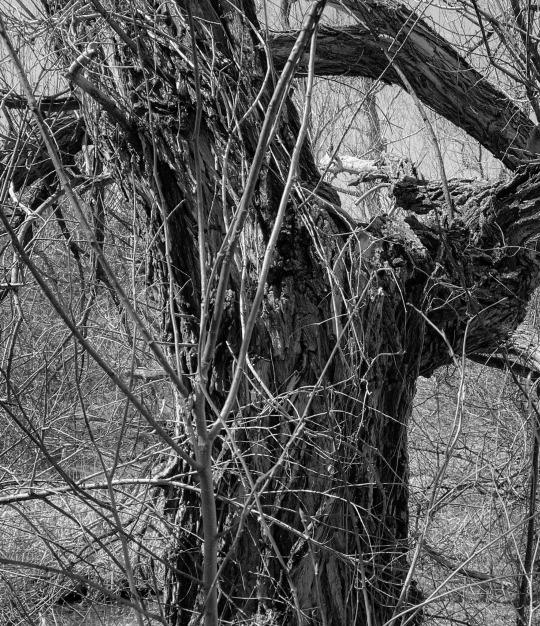
“Behold, my friends, the spring is come; the earth has gladly received the embraces of the sun, and we shall soon see the results of their love!”
Sitting Bull
2 notes
·
View notes
Text
The warrior is not someone who fights, because no one has the right to take another life. The warrior, is one who sacrifices himself for the good of others. His task is to take care of the elderly, the defenseless, those who can not provide for themselves, and above all, the children, the future of humanity.
#meaning of life#compassion quotes#words of wisdom#tribal quests#children are the future#how to live#chief of lakota nation#lakota nation#sitting bull#dakota tribe#tribe quotes#revolution quotes#help others#service to others#humanity quotes#spiritual quotes#life quotes#life reminders#life advice#spiritual journey#wise words#wisdom quotes#be kind#society quotes#be the change#earthquake in turkey#humanitarian aid#earthquake video#consciousness#higher self
25 notes
·
View notes


